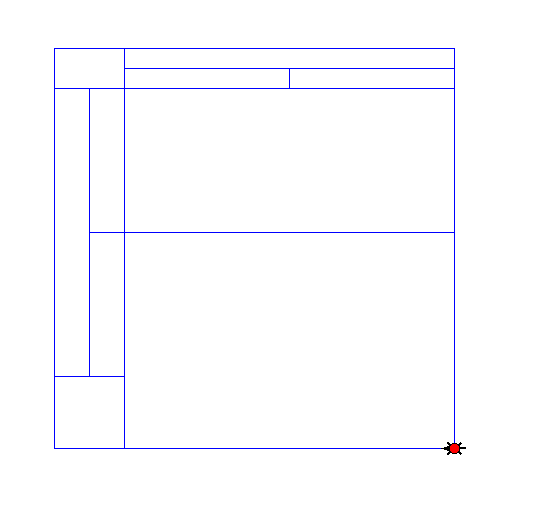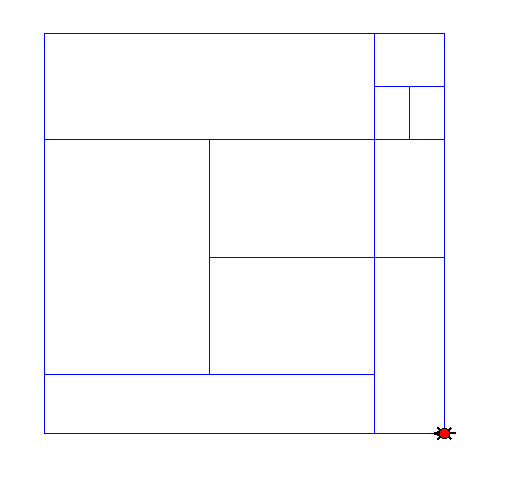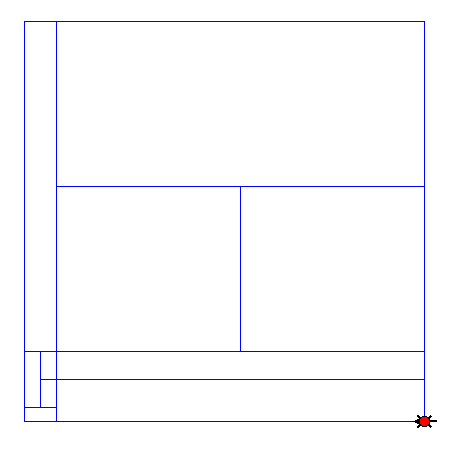User:Lieven Van Speybroeck/Prototyping/7-Bob Mondriaan
< User:Lieven Van Speybroeck
Revision as of 11:05, 14 June 2011 by Lieven Van Speybroeck (talk | contribs) (Created page with "Category: Turtle Graphics Category: prototyping Presenting Bob Mondriaan!<br> The idea is that the same code generates different 'paintings'. I tried using Inkscape to g...")
Presenting Bob Mondriaan!
The idea is that the same code generates different 'paintings'. I tried using Inkscape to get colors involved, but somehow, things are not working properly.
So for now, I can show the TurtleWorld output (colors are quite crucial, I know):
These images consist of full rectangles that could be filled with a random color (obviously white, blue, red or yellow).
The code is a bit of a mess, and I'm still thinking of how I could 'automate' more instead of all the hardcoding:
from TurtleWorld import *
import math
import random
world = TurtleWorld()
bob = Turtle()
bob.delay = 0.01
print bob
def rectangle(t, width, height):
for i in range(2):
fd(t, width)
rt(t)
fd(t, height)
rt(t)
def mondriaan(t, scale):
# omtrek
rectangle(t, scale, scale)
newWidth = random.randint(3,scale)
newHeight = random.randint(3,scale)
# rectangle 1
rectangle(t, newWidth, newHeight)
fd(t, newWidth)
restWidth = scale - newWidth
restHeight = scale - newHeight
# rectangle 2
rectangle(t, restWidth, newHeight/2)
rt(t)
fd(t, newHeight/2)
lt(t)
# rectangle 3
for i in range(2):
rectangle(t, restWidth/2, newHeight/2)
fd(t, restWidth/2)
rt(t)
fd(t, newHeight/2)
#rectangle 4
rectangle(t, restHeight/2.5, restWidth)
rt(t)
fd(t, restWidth)
lt(t)
#rectangle 5
for i in range(2):
rectangle(t, restHeight/2.5, newWidth/2)
fd(t, restHeight/2.5)
rt(t)
fd(t, newWidth/2)
#rectangle 6
rectangle(t, newWidth/2, (restHeight/2.5)*2)
fd(t, newWidth/2)
lt(t)
lt(t)
#rectangle 7
rectangle(t, newWidth, (restHeight/2.5)*0.5)
pu(t)
fd(t, scale)
rt(t)
fd(t, (restHeight/2.5)*0.5)
rt(t)
pd(t)
#rectangle 8
rectangle(t, restWidth, (restHeight/2.5)*1.5)
mondriaan(bob, 400)
wait_for_user()
SVG code (not working... but we could have a look at it)
import random
import math
def rectangle(width, height):
for i in range(2):
pd()
fd(width)
rt(90)
fd(height)
rt(90)
colors = ['255,0.0', '0,255,0', '0,0,255', '255,255,255', '0,0,0']
color = choice(color)
styles['fill'] = color
(pu)
def mondriaan(scale):
# omtrek
rectangle(scale, scale)
newWidth = random.randint(3,scale)
newHeight = random.randint(3,scale)
# rechthoek 1
rectangle(newWidth, newHeight)
fd(newWidth)
restWidth = scale - newWidth
restHeight = scale - newHeight
# rechthoek 2
rectangle(restWidth, newHeight/2)
rt(90)
fd(newHeight/2)
lt(90)
# rechthoek 3
for i in range(2):
rectangle(restWidth/2, newHeight/2)
fd(restWidth/2)
rt(90)
fd(newHeight/2)
#rechthoek 4
rectangle(restHeight/2.5, restWidth)
rt(90)
fd(restWidth)
lt(90)
#rechthoek 5
for i in range(2):
rectangle(restHeight/2.5, newWidth/2)
fd(restHeight/2.5)
rt(90)
fd(newWidth/2)
#rechthoek 6
rectangle(newWidth/2, (restHeight/2.5)*2)
fd(newWidth/2)
lt(90)
lt(90)
#rechthoek 7
rectangle(newWidth, (restHeight/2.5)*0.5)
pu()
fd(scale)
rt(90)
fd((restHeight/2.5)*0.5)
rt(90)
pd()
#rechthoek 8
rectangle(restWidth, (restHeight/2.5)*1.5)
mondriaan(400)



